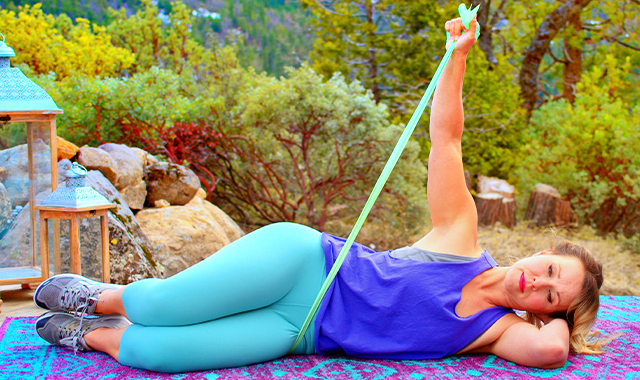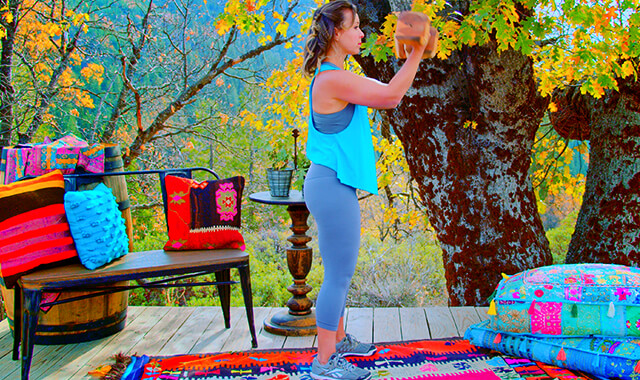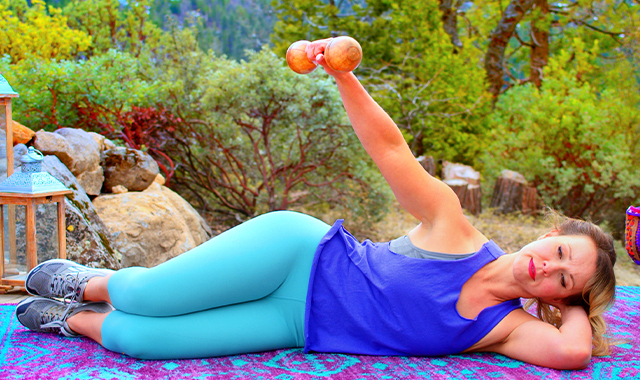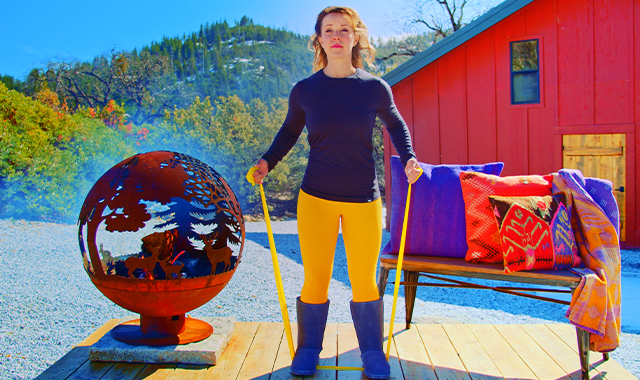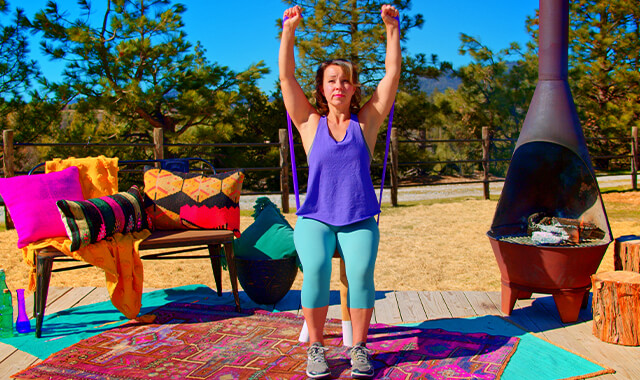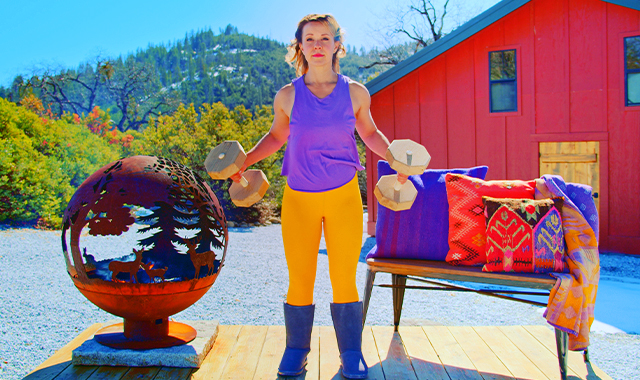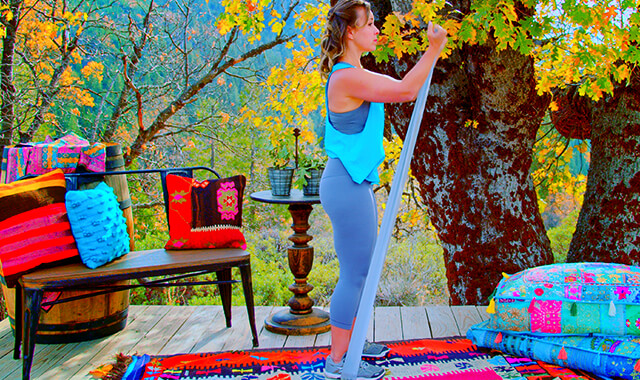Incline Band Lateral Delt Raise
How to Do the Incline Band Side Delt Raise - Side of Body on Swiss Ball | In-Depth Guide [VISUAL LEARNERS]
Proper Form & Common Mistakes | Home Resistance Training
WHAT DO YOU WANT TO SEE?
QUICK DEMO
QUICK DEMO
MUSCLES THIS WORKS
MUSCLES
MAIN MUSCLES WORKED IN Incline Band Lateral Raises
LATERAL DELTOID
STARTING POINTERS
Starting Pointers
WHAT WE'RE DOING TODAY
ALL WE'RE DOING:
While leaning against a yoga ball, move your arm away from your body out to your side, like a bird taking flight.
This version of lateral deltoid raises is done in an inclined position over a stability band and uses a resistance band. The use of a stability ball will work the muscles of the core and legs more. This is a nice option if you don’t have a dumbbell and only have short resistance bands.
HOW TO DO THE EXERCISE
LOOKS
HOW Incline Band Lateral Delt Raises SHAPE OUR BODY
The exercise will tone and build the muscles of the top of the shoulder and the arm. It adds to that capped shoulder look.
When you train the shoulder muscles, it helps make the waist look smaller as well.
I personally love the capped shoulder look, so it’s something I have made a mainstay of my routine.
PROPER FORM
PROPER FORM: Incline Band Lateral Delt Raises
EQUIPMENT, SETS & REPS
EQUIPMENT
Main set (3: Light/Med/Heavy)
X-Heavy Band (I recommend getting this too if you plan to use resistance bands frequently).
SUGGESTED STARTING WEIGHT FOR WOMEN:
Light to moderate
SETS & REPS:
2-3 Sets, 8-10 Reps
PACE:
BODY POSITION
BODY POSITION FOR THE Incline Band Lateral Raise
Lie over a stability ball - the side of your torso is on the ball. The ball supports your torso from underarm to hips (roughly - depends on length or torso and size of ball). The upper part of your arm of your non working side is on the ball and the knee(s) on the floor to stabilize your body in an inclined position. Your hips are off of the floor.
Band is anchored under your bottom knee, and your other end is held in your hand of the top arm.
BODY STANCE: Neutral spine. The ball helps to support your spine in a neutral position. The head, shoulder, torso and hips should be in a straight line. Sternum lifted, shoulders back, chest open, shoulder blades in and down the back.
LEG/FOOT: Your legs and feet should be positioned so that your body is stable. Options include: 1) both knees bent feet stacked; 2) Top leg straight, bottom leg bent;
HAND/GRIP: Grip the end of your band with a neutral grip. Thumb will point forward (same way the body is facing). The band taut in the starting position.
ARM: Your working arm (top arm) is straight and lying along the side of your body, or just slightly in front of your hip. The bottom arm is on the ball, the upper part of your arm in contact with the ball, elbow bent and resting head in hand. Some people may prefer to put the hand on the floor to help stabilize, or hold on to the ball - your non working arm should be comfortable and stable.
HOW TO DO
HOW TO DO Incline Resistance Band Lateral Delt Raises
CUE: If the ball is moving around too much, set it just touching a wall to help stabilize it.
Lift your top arm up until it is at 90 degrees of abduction (straight up in line with the shoulder).
Slowly lower your arm back down but do not let your arm touch the side of your body - keep tension on the muscle. Begin the next rep.
HOW TO SAFELY GET OUT OF THE EXERCISE
At the bottom of the movement, set your arm on the side of your torso. Release the band. Lower your hips down to the floor.
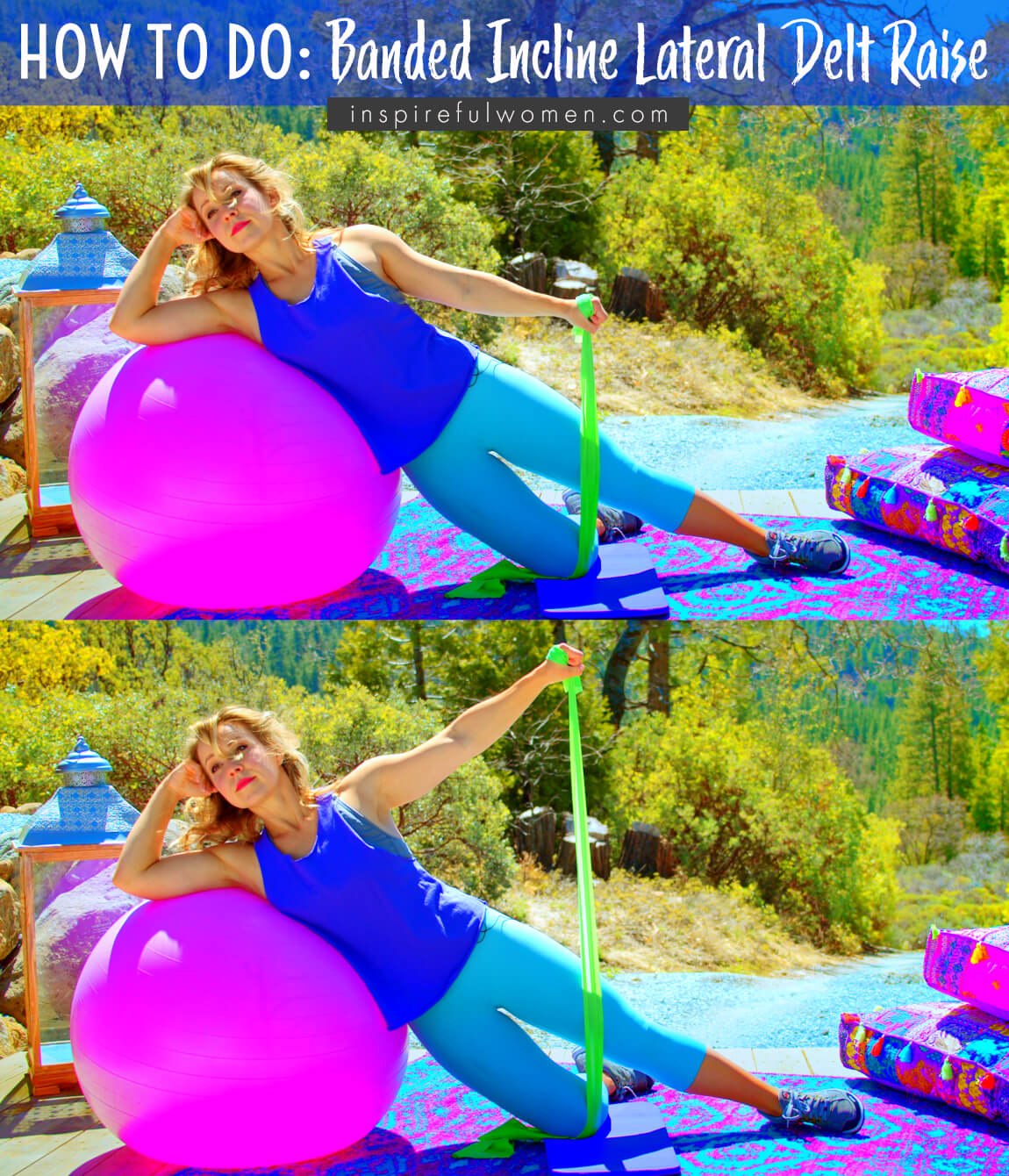
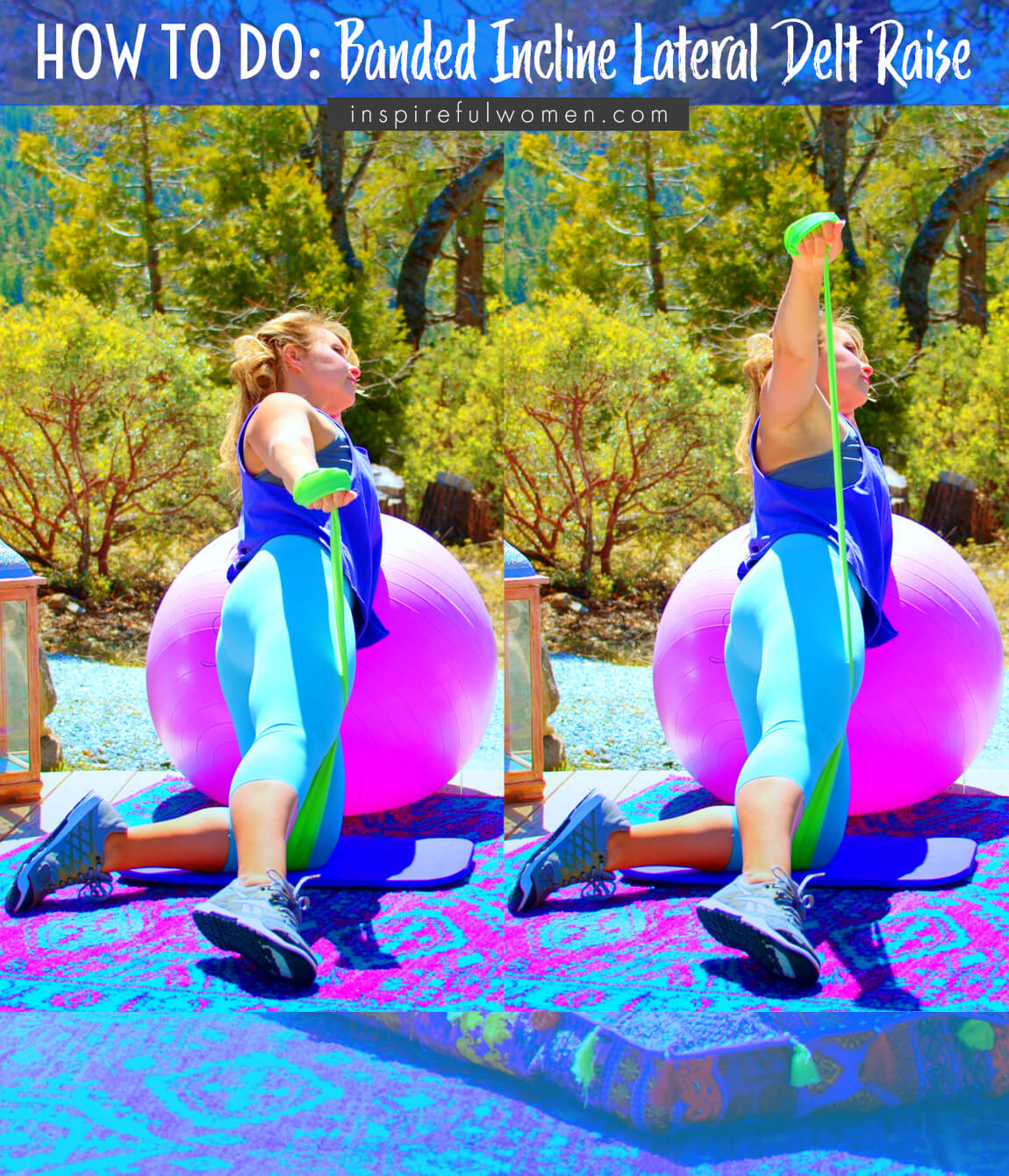
COMMON MISTAKES
COMMON MISTAKES
WHAT TO AVOID WITH Incline Band Lateral Raises
KEY TIP:
Guess what? Good news! Many avoids are the same for most movements. Once you learn the basics, there's really only a few extra avoids for each individual movement.
1. Avoid hands above shoulders
AVOID: Avoid hands above shoulders.
WHY NOT?
- This will not increase the work the muscles are doing
- This position can increase the risk for pinching the supraspinatus muscle (shoulder impingement).
- Lifting higher can promote low back extension (as compensation when the deltoid fatigues).
WHAT TO DO:
- Monitor height of hands, they should not be higher than the shoulders.
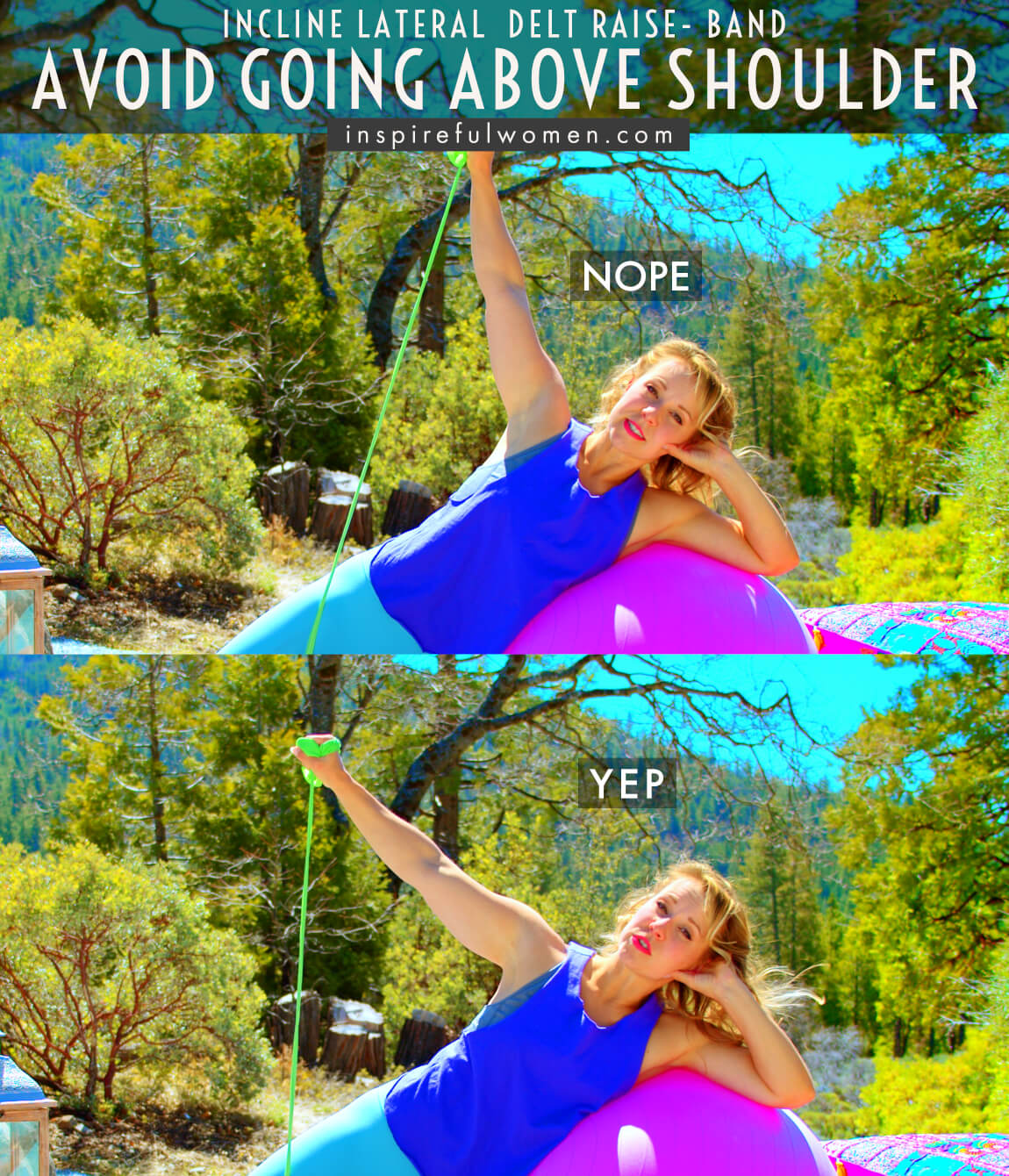
2. Avoid Bringing Shoulders Up Towards Ears
AVOID: Avoid hunching up shoulders.
WHY NOT?
- This will activate your upper traps (trapezius) and compress the vertebrae in your neck. Your upper trapezius is located on either side of your neck, where your bra straps would usually sit. These muscles can get too involved in LOTS of movements and lead to excessive muscle growth here that most of women don't really want, AND also cause tension in our shoulders and neck.
WHAT TO DO: Keep shoulders pressed down.
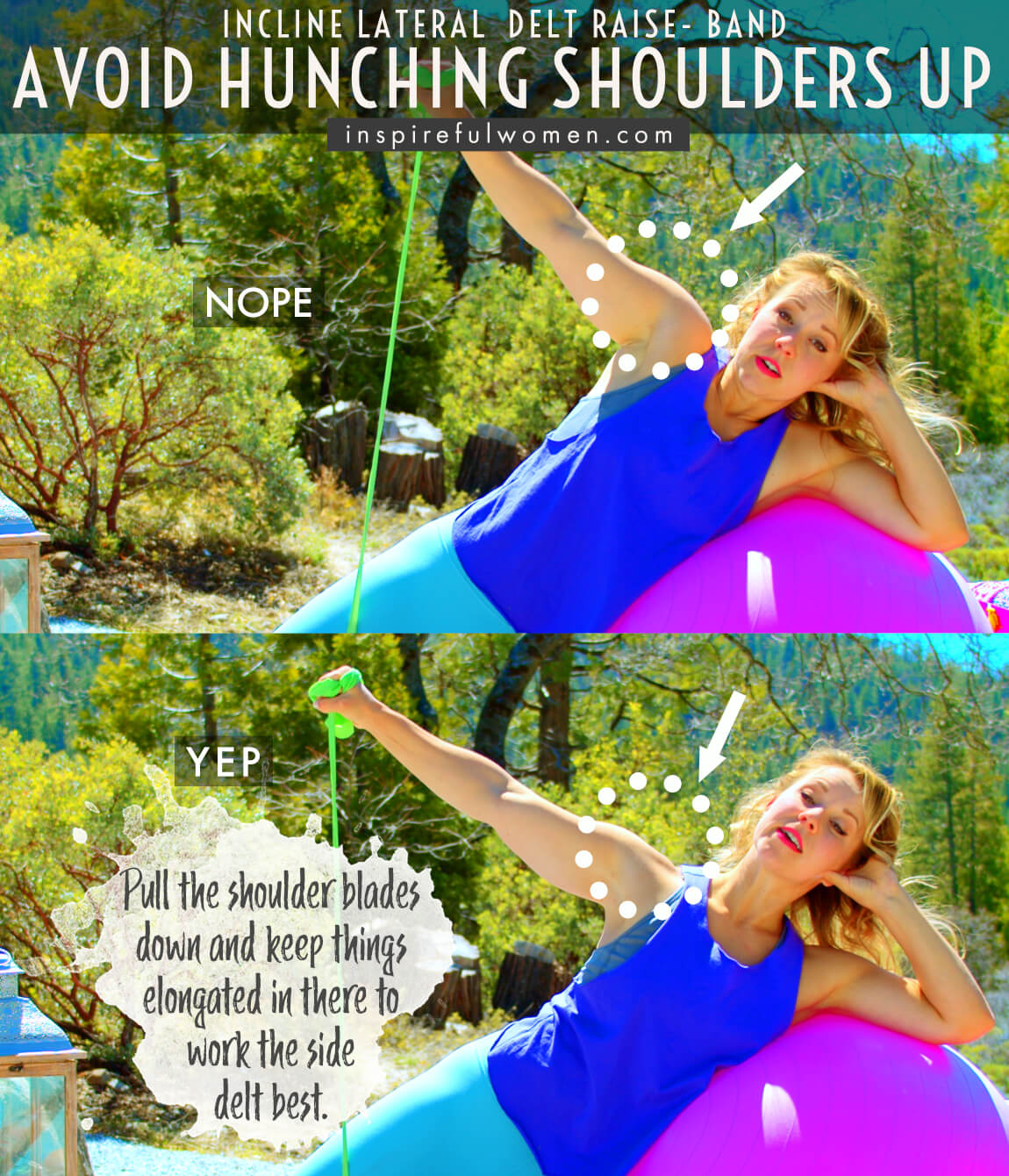
3. avoid hip dropping
AVOID: Avoid hips dropping or pushing out.
WHAT TO DO:
- Keep hips in alignment with the rest of the body.
- Think of your head to knees as one straight line tipped over in a diagonal line.
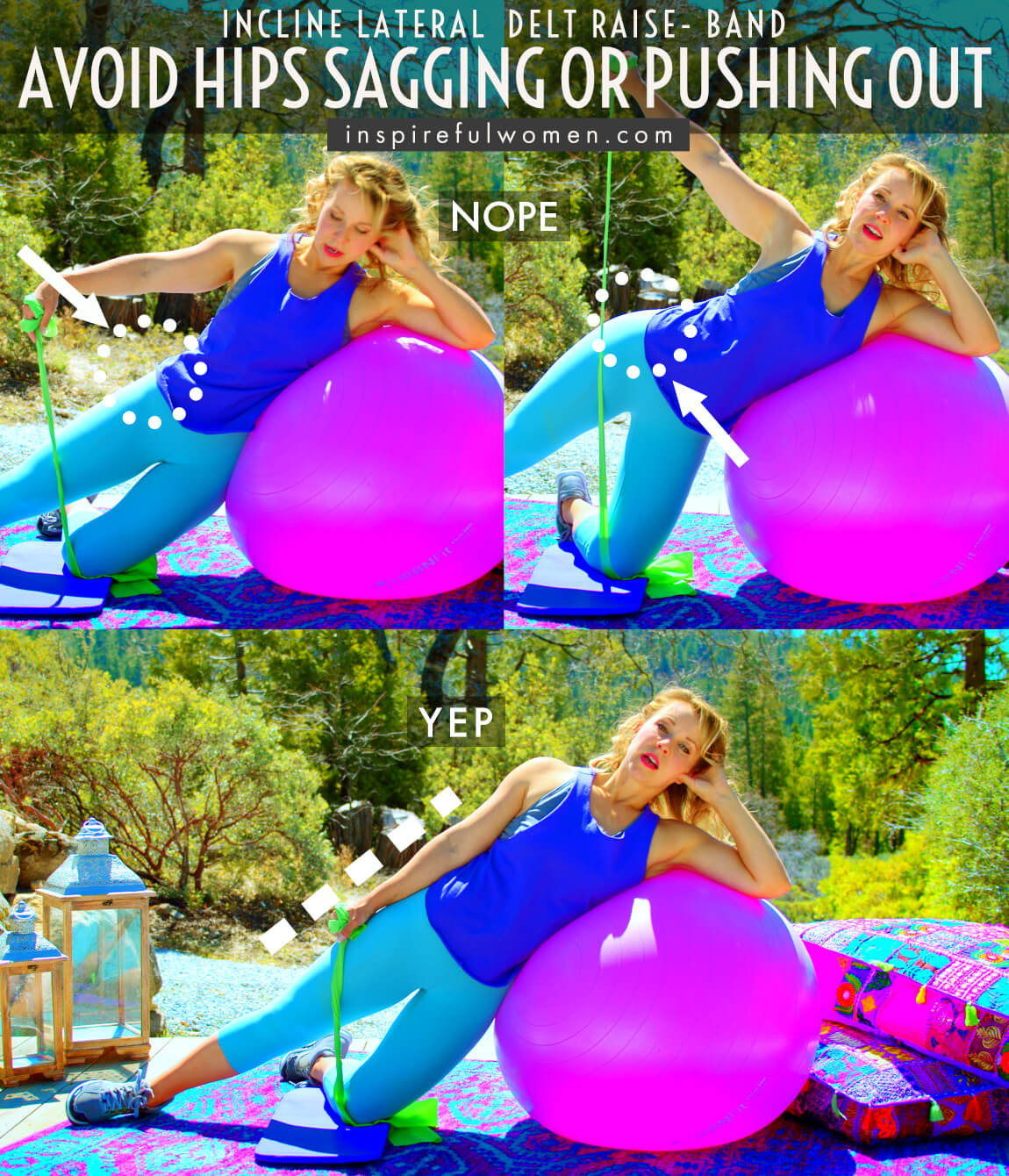
4. avoid bending elbow
AVOID: Avoid letting the elbow bend.
WHY NOT?
- Bending the elbow when the hand gets close to the floor can cause you to start substituting using the triceps to initiate the lift instead of the supraspinatus and lateral deltoid.
WHAT TO DO:
- Only lower the arm down as far as you are able to without bending the elbow.

5. avoid hands drifting forward
AVOID: Avoid letting the arm drift to the front of the body.
WHY NOT?
- Moving the arm in front of the body will use the anterior portion of the deltoid muscle.
WHAT TO DO:
- Keep your arm directly to your side.
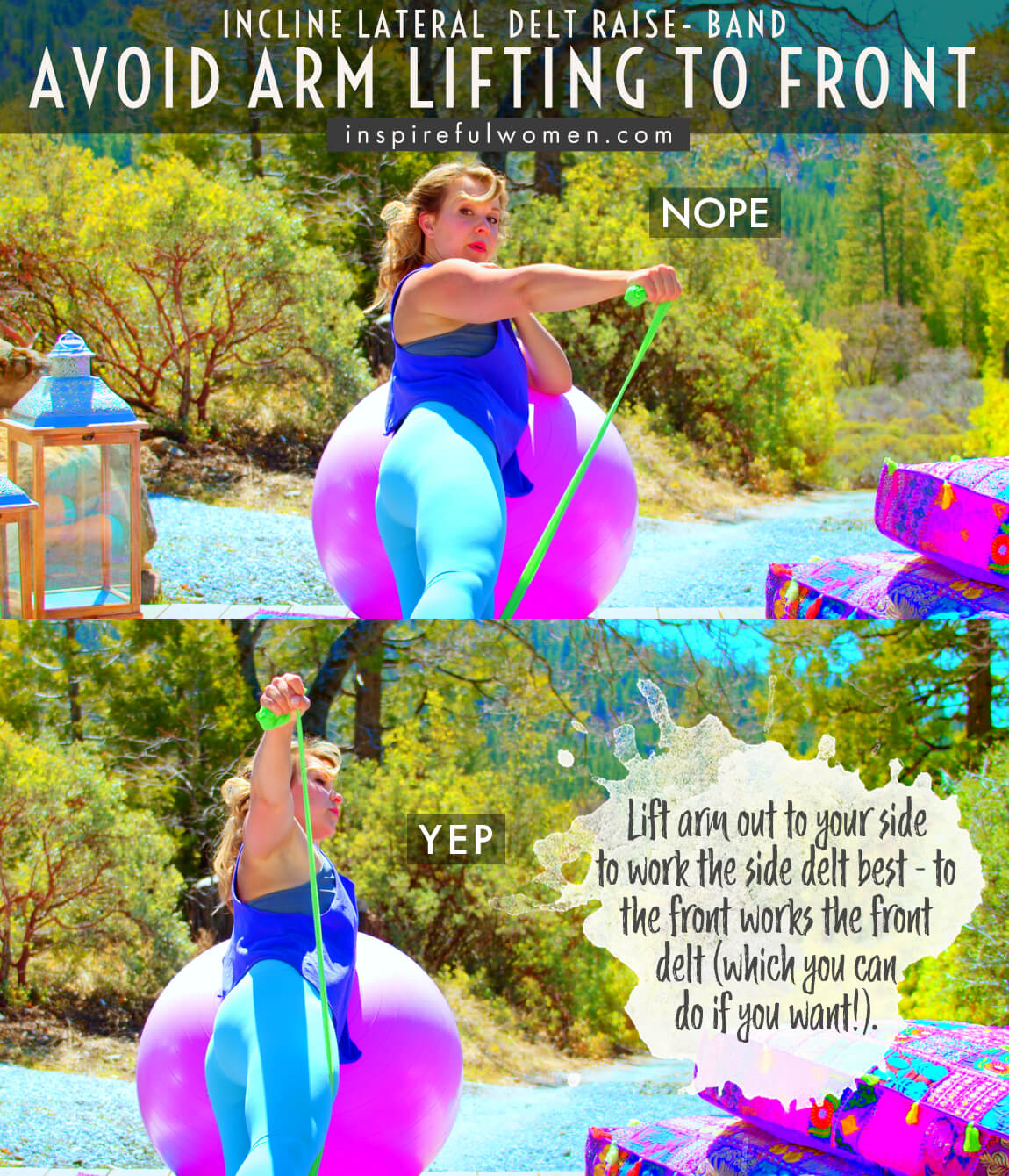
6. Avoid Bending Spine
AVOID: Avoid flexing/extending the spine.
WHY NOT?
- Repetitive movement through the spine can be irritating to the joints, discs and tissues.
- Moving through the back to get the weights higher will not make the shoulder muscles work harder.
WHAT TO DO:
- Keep your core muscles engaged to stabilize the torso and limit the movement to the shoulders.
- You should be able to draw a line straight down the side of the body.
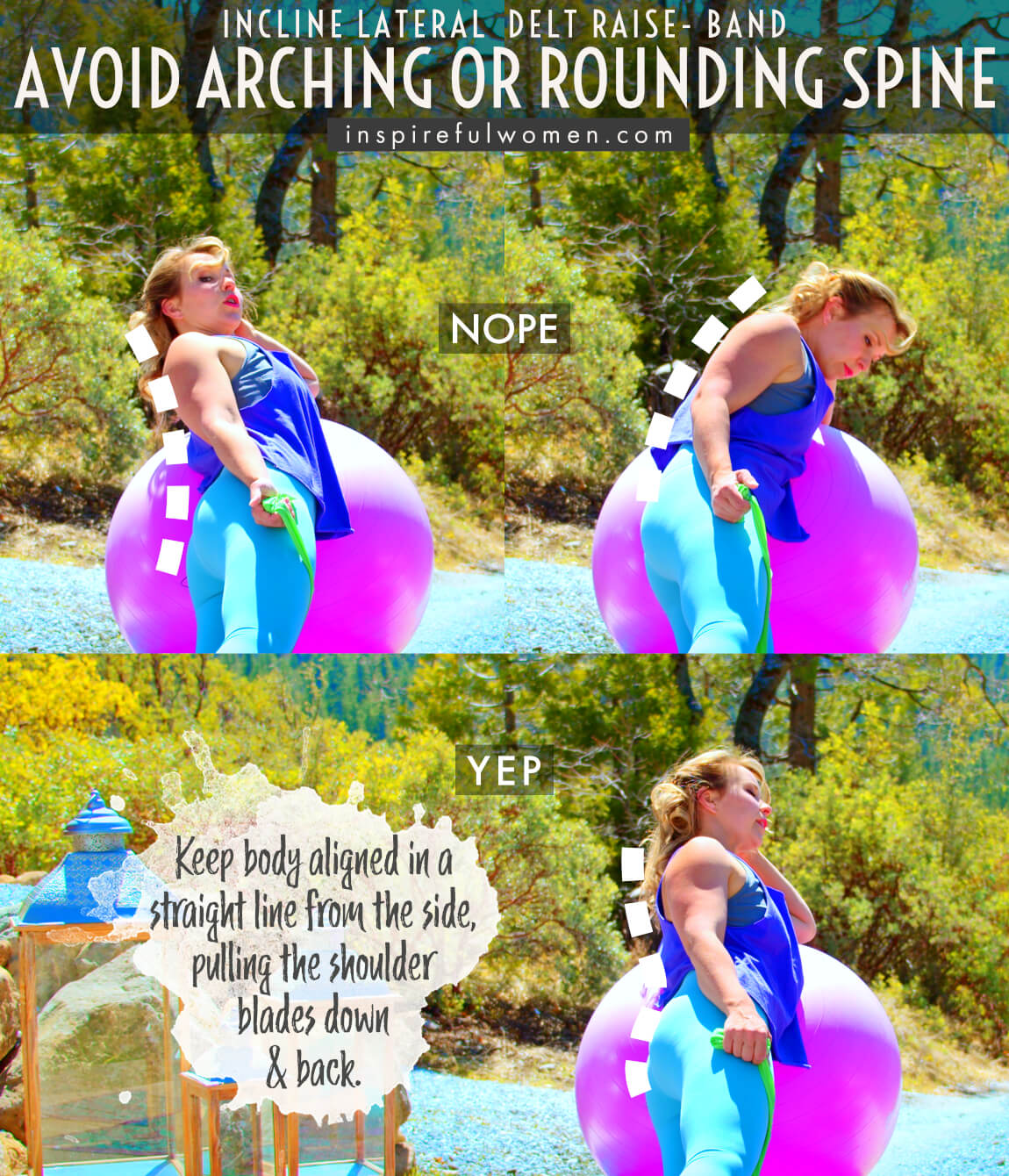
7. Avoid Bending Neck
AVOID: Avoid tilting the neck.
WHY NOT?
- This can strain the muscles along the spine.
WHAT TO DO:
- Let your gaze go with the same degree that your torso bends over.
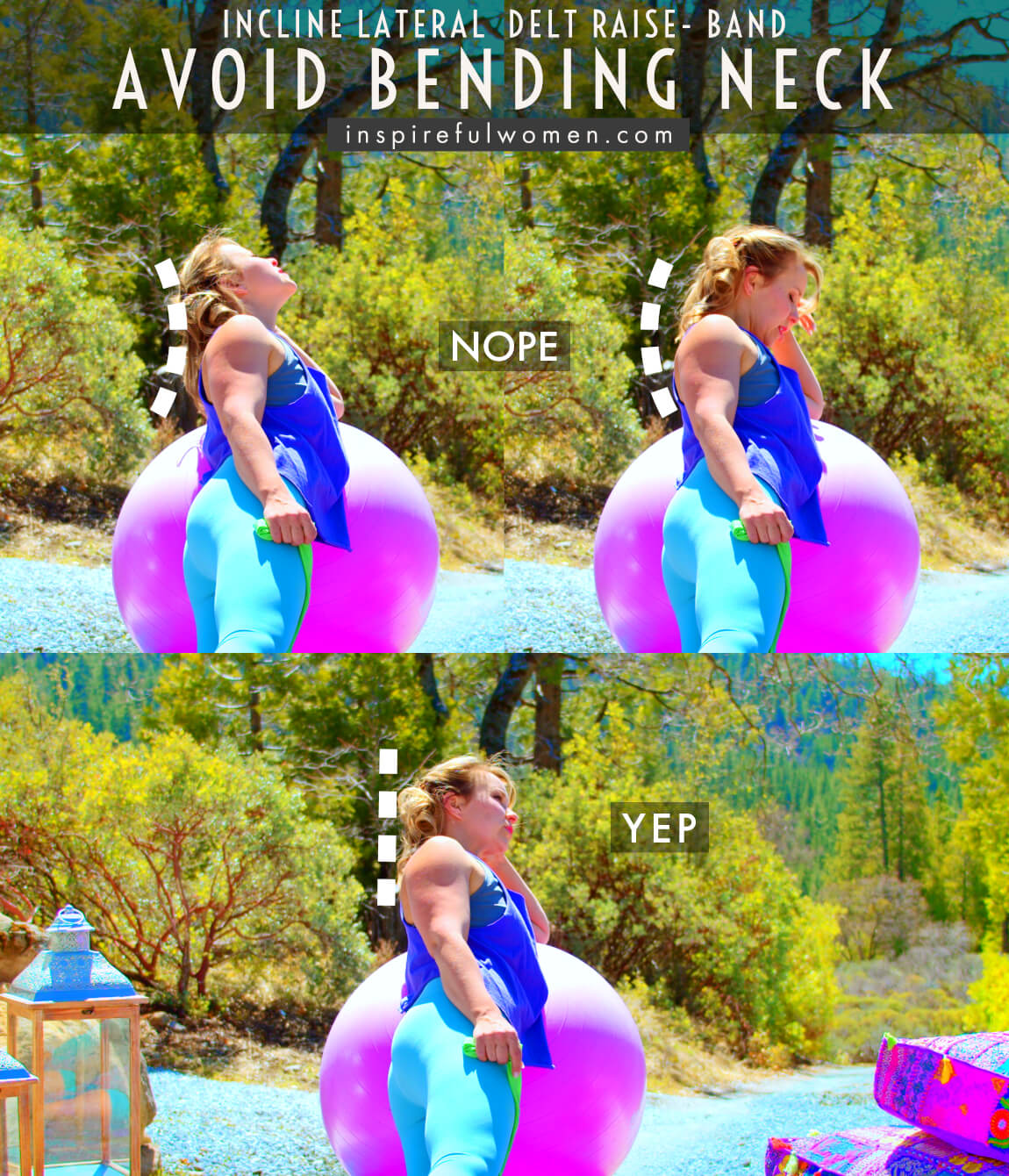
8. Avoid Bending Wrist
AVOID: Avoid tilting the neck.
WHY NOT?
- This can strain the muscles along the spine.
WHAT TO DO:
- Let your gaze go with the same degree that your torso bends over.
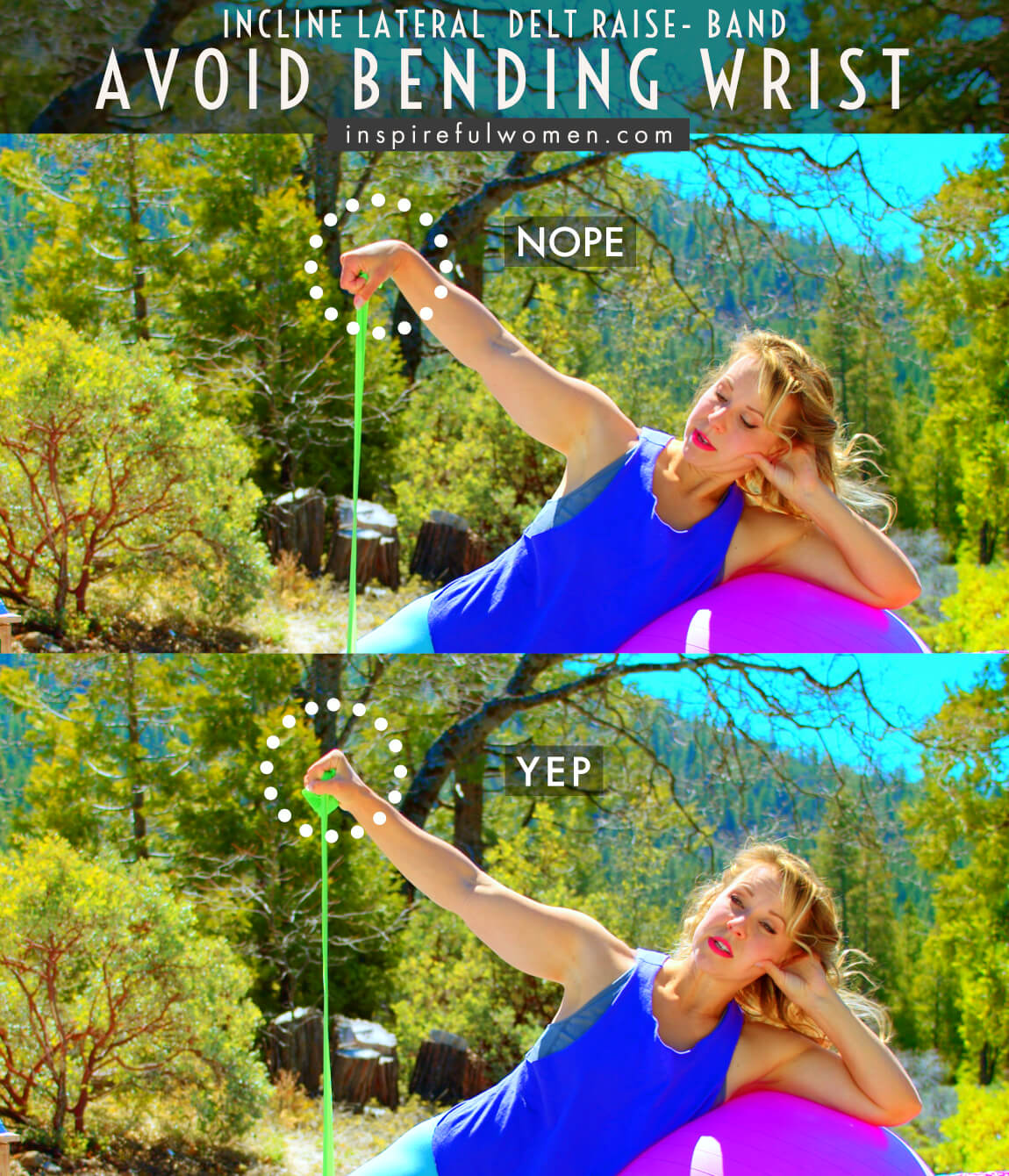
WHAT WE'RE DOING TODAY
WHAT & WHY
BENEFITS OF TRAINING THE lateral deltoid
WHAT
We are hitting the side of our shoulder muscle today folks!
Main shoulder muscle = Deltoid.
Side portion of that muscle = Lateral Delt.
Why we're bothering to "hit" it in a minute.
The side lateral deltoid raise exercises focuses on working the middle (or lateral) portion of the deltoid and the supraspinatus (one muscle of the rotator cuff), with little input from the other parts of the deltoid muscle. There aren’t really a ton of exercises that target this muscle very well, so this is one of the really great core movements to use for training this muscle.
KEY TIP is to only raise the arms to shoulder height, no higher, to protect the health of your shoulders.
WHY BOTHER DOING IT?
WHY
WHY DO WE EVEN CARE?
The lateral delt, which remember is just a fancy word to say the side of your shoulder muscle, is used daily for activities that have to do with carrying items out to our sides or raising items out to our sides.
KEEP MUSCLES BALANCED IN RELATION TO EACH OTHER
All 3 parts of the shoulder muscle- the front, side, and back of the deltoid (which are called the anterior, lateral & posterior parts of the delt) work together to move and support the shoulder joint. It is important to include exercises that target each one of these portions of the muscle to keep all portions of the muscle balanced.
Many people only include exercises that work the front of the deltoid muscle, creating an imbalance that can pull the upper arm forward.
HELP RECTIFY IMBALANCE CAUSED BY DAILY MODERN LIFE
Another thing that can contribute to an imbalance is that much of our daily activities are done in front of our bodies, like working on a computer, writing, eating, driving, and reading. This can result in a rounded shoulder posture, and it can interfere with how the shoulder joint moves. Doing lateral raises will help to balance this out by increasing the strength of the side delt.
EFFECTIVE EXERCISE FOR THIS MUSCLE
Effective training for the lateral deltoid involves lifting your arm out to the side, away from the body. The lateral deltoid raise is exactly that. The exercise targets the lateral deltoid and supraspinatus by keeping the torso stable while lifting the arm out to the side. The addition of a weight serves two purposes, it pulls the arm down in the shoulder socket (the lateral deltoid and supraspinatus will work to hold the upper arm bone up in the socket), and it works the muscles as the arm is lifted up out to the side of the body.
A well-designed exercise program will include exercises that target each portion of the deltoid muscle. If one part of the deltoid is not strong enough, it can cause improper movement of the shoulder joint, which over time can cause damage.
EVERYDAY LIFE
EVERYDAY LIFE &
MUSCLE FUNCTION
HOW WE USE OUR lateral deltoid MUSCLES IN EVERYDAY LIFE
1. LIFTING ARMS STRAIGHT OUT TO YOUR SIDES
This is called abduction & nope, it doesn't involve your arms being abducted by aliens, a good thing wheww. Think about how many movements we do throughout the week, I mean even throughout the DAY that involve our arms moving out to the sides or holding them out to the sides of us in some way, which is its main function:
- Dressing
- Washing, drying your hair
- Brushing teeth
- Pulling up socks or pants
- Carrying kids on your hip
- Lots of stuff with kids
2. STABILIZING YOUR SHOULDER JOINT
Pulls upward on our upper arm bone (humerus) against downward pulls. This helps ensure the bone stays in the right place on the body so the joint doesn't get damaged.
- Carrying heavy items down at your side like:
- Multiple bags of groceries anyone?
- Buckets
- Luggage (you should stop doing that and get one with rollers btw)
QUICK NOTE: The lateral deltoid is not actually it's own muscle - it's 1 part of a larger muscle (just "the deltoid") that has 3 main parts. I needed to clarify that or Carol the PT I work with will probably kill me. Just kidding, she's way too nice to do that.
HOW TO FEEL WHAT MUSCLE IS WORKING
How to Feel What Muscle is Working
Place your fingers of one hand on the top of the opposite shoulder. Lift the arm straight out to the side.
SCIENCY STUFF
SCIENCY STUFF
SPIFFILICIOUS FACTS ABOUT MUSCLES & MOVES
As we've discussed, the lateral deltoid muscle is what moves the arm away from the body out to the SIDE of you.
This is the movement that you would use to lift your arm out to put your arm into the sleeve of a coat, or lift and carry items out to the side, such as groceries, buckets, a suitcase, or carrying a child on your hip. The lateral deltoid works with the supraspinatus (one of the rotator cuff muscles) to perform this movement. Although the primary function of the lateral deltoid is to lift the arm out to the side, if you lift an object that is too heavy for another portion of the deltoid to lift (regardless of where the arm is) the lateral deltoid will assist the other portions of the deltoid.
The three portions of the deltoid muscle are all insert on the upper arm bone through one tendon. Anytime that one of the portions of the muscle is not strong enough to do its job, the other portions of the deltoid will help. If you use a heavy weight, The front of the delt (anterior) and posterior delt (rear) of the deltoid muscle are also active. The different portions of the deltoid can be targeted by changing the position of the arm relative to the body and also with rotation of the arm.
This lateral deltoid raise will also strengthen all of the rotator cuff muscles and the muscles that move the shoulder blade which contributes to good posture.
Another very important function of the lateral deltoid muscle is to hold the upper arm bone (humerus) in the socket of the shoulder joint. The shoulder joint is a very unstable ball and socket joint. The role of the muscles that stabilize the joint is to hold the ball or head of the upper arm bone (humerus) centered in the socket when holding an object and with the movement of the arm. Gravity and the other rotator cuff muscles (all but the supraspinatus - teres minor, infraspinatus, and subscapularis) are positioned to move the head of the humerus down in the socket. The lateral deltoid (with assistance from the other portions - but it depends on exactly how the arm is being pulled down) contracts to hold the head of the upper arm bone (the humerus) up and centered in the socket. This is important for avoiding shoulder injuries of the rotator cuff muscles and preventing degenerative changes in the joint.
The way that these muscles act together to hold the ball in the socket is known as a force couple - the muscles each pulling in different directions to stabilize the joint. It is important that all portions of the deltoid and the rotator cuff are exercises in ways that will train the muscles to stabilize the joint.
ALLLL MUSCLES & WHEN
ALL MUSCLES WORKING & WHEN DURING THE Incline Band Lateral Delt Raise
Rotator cuff and shoulder blade muscles work to stabilize the shoulder joint throughout the movement. The muscles of the upper arm and forearm are working isometrically to hold the elbow and wrist joints still during the arm lift.
Core, nonworking arm, and legs are active to stabilize and keep the body in alignment as it leans over the ball.
The supraspinatus (one of the rotator cuff muscles that acts to abduct the shoulder) muscle will be most active at the beginning of the movement, the lateral deltoid will help a bit but it is pretty weak in this position. As the arm moves up the supraspinatus contributes less and the lateral deltoid will contribute more. At 60 degrees of abduction, the supraspinatus will continue to work to stabilize the shoulder joint but will not participate much in shoulder abduction. The supraspinatus and lateral deltoid work concen
The deltoid and supraspinatus will work eccentrically to lower the arm back towards the torso.
PIN IT FOR LATER!



